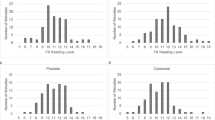Abstract
This study aimed to evaluate the type, content, accessibility and quality of information available via the internet for patients with head and neck cancer. The Google search engine was used to generate lists of the first 100 websites for general head and neck cancer and the first ten for head and neck cancers by anatomical location (160 total). Websites were evaluated with the validated DISCERN and LIDA instruments, the SMOG (Simple measure of gobbledygook) readability score and against the JAMA (Journal of the American Medical Association) criteria. 40 of the 160 websites ranked by Google were suitable for analysis. Seven websites (17.5 %) partially or fully achieved all four JAMA benchmarks and only one (2.5 %) site achieved none. 28 (70 %) included reference to quality of life factors. Correlations were identified between Google site rank and all four of our appraisal tools; LIDA (−0.966, p = 0.006), JAMA (−5.93, p = 0.028), DISCERN (−0.568, p = 0.037) and SMOG (4.678, p = 0.04). Google site rank and both government run sites (−35.38, p = 0.034) and sites run by universities or hospitals (−27.32, p = 0.016) also showed an association. Comparing our observations with those of Riordain in 2008, there has been little improvement in the quality of head and neck cancer information available online over this time. Given the variability in quality of information online, patients would benefit from being directed to reliable websites by clinicians
Similar content being viewed by others
References
Scottish Health Council (2011) A Scottish Health Council Report on participation and online technology. Healthcare Improvement Scotland
The E Word. Search Engine Market Share. http://theeword.co.uk/info/search_engine_market.html. Accessed 24 Aug 2014
Riordain RN, McCreary C (2008) Head and neck cancer information on the internet: type, accuracy and content. Oral Oncol 45:675–677
National Institute for Clinical Excellence (2004) Guidance of Cancer Services: Improving Outcomes in Head and Neck Cancers. London
Boyer C, Provost M, Baujard V (2002) Highlights on the 8th HON survey of health and medical internet users. Health on the Net Foundation, Geneva
Granka LA, Joachims T, Gay G (2004) Eye-tracking analysis of user behavior in WWW Search. SIGIR 1–2
Charnock D, Shepperd S (2004) Learning to DISCERN online: applying an appraisal tool to health websites in a workshop setting. Health Educ Res 19:440–446
Minervation. The Minervation validation instrument for healthcare websites (LIDA tool). http://www.minervation.com/lida-tool/. Accessed 23 Aug 2014
Silberg WM, Lundberg GD, Musacchio R (1997) Assessing, controlling and assuring the quality of medical information on the internet. JAMA 277(15):1244–1247
Child D. Readability-Score.com. https://readability-score.com. Accessed 23 Aug 2014
Fitzsimmons PR, Michael BD, Hulley JL, Scott GO (2010) A readability assessment of online Parkinson’s disease information. J R Coll Physicians Edinb. 40(4):292–296
Sharma N, Tridimas A, Fitzsimmons PR (2014) A readability assessment of online stroke information. J Stroke Cerebrovasc Dis 23(6):1362–1367
Al-Bahrani A, Plusa S (2003) The quality of patient-orientated internet information on colorectal cancer. Colorectal Dis 6:323–326
Sajid M, Iftikhar M, Monteiro RS, Miles AFW, Woods WGA, Baig MK (2007) Internet information on colorectal cancer: commercialization and lack of quality control. Colorectal Dis 10:352–356
Stinson J, White M, Breakley V, Chong AL, Mak I, Low KK, Low AK (2011) Perspectives on quality and content of information on the internet for adolescents with cancer. Pediatric Blood Cancer. 57:97–104
Scottish Intercollegiate Guidelines Network (2006) Diagnosis and management of head and neck cancer. Edinburgh
Conflict of interest
None declared.
Author information
Authors and Affiliations
Corresponding author
Rights and permissions
About this article
Cite this article
Best, J., Muzaffar, J. & Mitchell-Innes, A. Quality of information available via the internet for patients with head and neck cancer: are we improving?. Eur Arch Otorhinolaryngol 272, 3499–3505 (2015). https://doi.org/10.1007/s00405-014-3349-z
Received:
Accepted:
Published:
Issue Date:
DOI: https://doi.org/10.1007/s00405-014-3349-z




